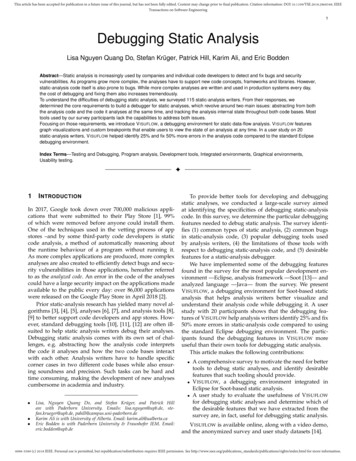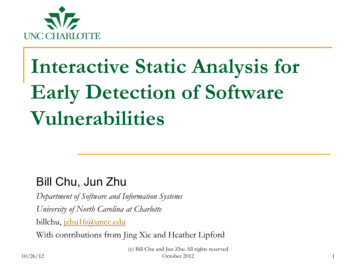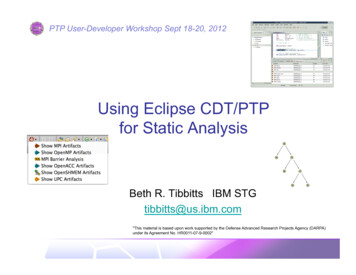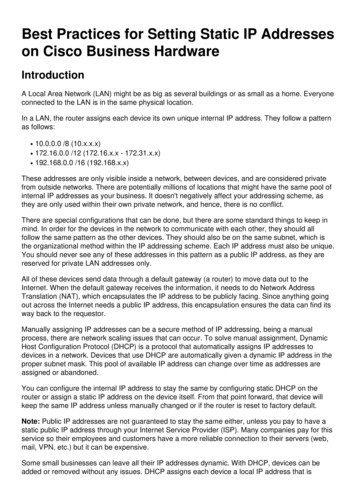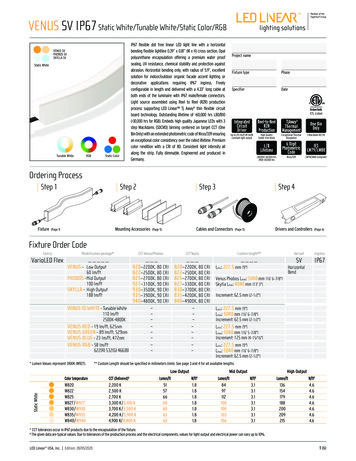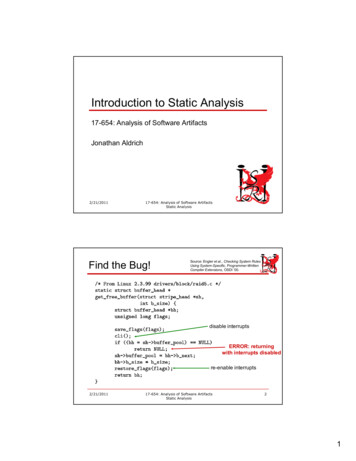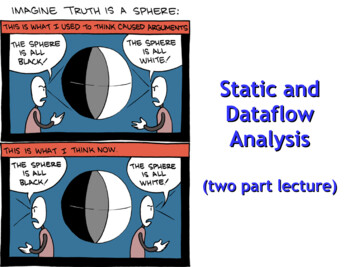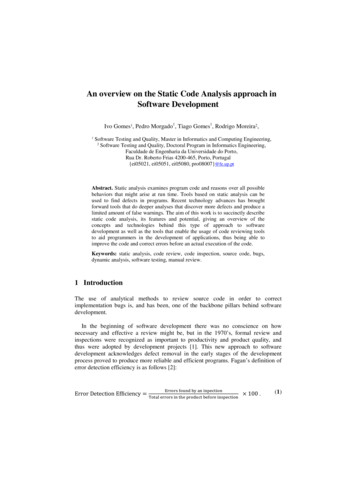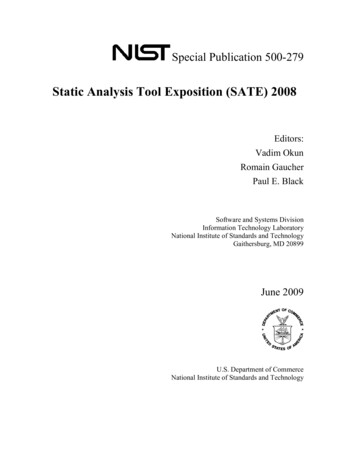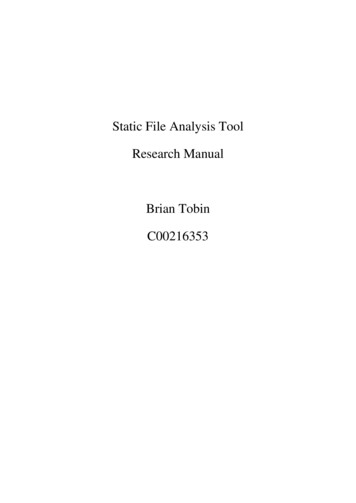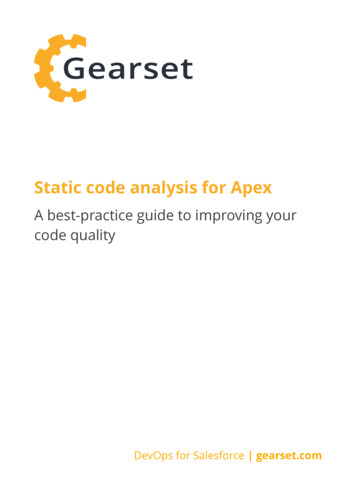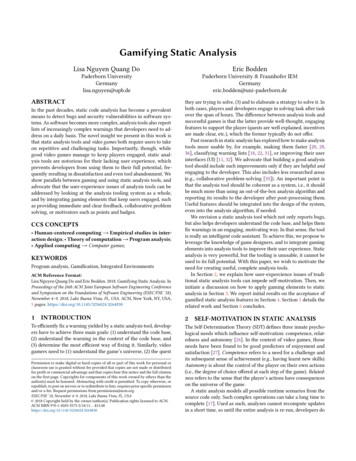
Transcription
Gamifying Static AnalysisLisa Nguyen Quang DoEric BoddenPaderborn UniversityGermanylisa.nguyen@upb.dePaderborn University & Fraunhofer IEMGermanyeric.bodden@uni-paderborn.deACM Reference Format:Lisa Nguyen Quang Do and Eric Bodden. 2018. Gamifying Static Analysis. InProceedings of the 26th ACM Joint European Software Engineering Conferenceand Symposium on the Foundations of Software Engineering (ESEC/FSE ’18),November 4–9, 2018, Lake Buena Vista, FL, USA. ACM, New York, NY, USA,5 pages. https://doi.org/10.1145/3236024.3264830they are trying to solve, (3) and to elaborate a strategy to solve it. Inboth cases, players and developers engage in solving task after taskover the span of hours. The difference between analysis tools andsuccessful games is that the latter provide well-thought, engagingfeatures to support the player (quests are well explained, incentivesare made clear, etc.), which the former typically do not offer.Past research in static analysis has explored how to make analysistools more usable by, for example, making them faster [20, 28,36], classifying warning lists [18, 22, 31], or improving their userinterfaces (UI) [11, 32]. We advocate that building a good analysistool should include such improvements only if they are helpful andengaging to the developer. This also includes less researched areas(e.g., collaborative problem-solving [35]). An important point isthat the analysis tool should be coherent as a system, i.e., it shouldbe much more than using an out-of-the-box analysis algorithm andreporting its results to the developer after post-processing them.Useful features should be integrated into the design of the system,even into the analysis algorithm, if needed.We envision a static analysis tool which not only reports bugs,but also helps developers understand the code base, and helps themfix warnings in an engaging, motivating way. In that sense, the toolis really an intelligent code assistant. To achieve this, we propose toleverage the knowledge of game designers, and to integrate gamingelements into analysis tools to improve their user experience. Staticanalysis is very powerful, but the tooling is unusable, it cannot beused to its full potential. With this paper, we wish to motivate theneed for creating useful, complete analysis tools.In Section 2, we explain how user-expercience issues of traditional static analysis tools can impede self-motivation. Then, weinitiate a discussion on how to apply gaming elements to staticanalysis in Section 3. We report initial results on the acceptance ofgamified static analysis features in Section 4. Section 5 details therelated work and Section 6 concludes.12ABSTRACTIn the past decades, static code analysis has become a prevalentmeans to detect bugs and security vulnerabilities in software systems. As software becomes more complex, analysis tools also reportlists of increasingly complex warnings that developers need to address on a daily basis. The novel insight we present in this work isthat static analysis tools and video games both require users to takeon repetitive and challenging tasks. Importantly, though, whilegood video games manage to keep players engaged, static analysis tools are notorious for their lacking user experience, whichprevents developers from using them to their full potential, frequently resulting in dissatisfaction and even tool abandonment. Weshow parallels between gaming and using static analysis tools, andadvocate that the user-experience issues of analysis tools can beaddressed by looking at the analysis tooling system as a whole,and by integrating gaming elements that keep users engaged, suchas providing immediate and clear feedback, collaborative problemsolving, or motivators such as points and badges.CCS CONCEPTS Human-centered computing Empirical studies in interaction design; Theory of computation Program analysis; Applied computing Computer games;KEYWORDSProgram analysis, Gamification, Integrated EnvironmentsINTRODUCTIONTo efficiently fix a warning yielded by a static analysis tool, developers have to achieve three main goals: (1) understand the code base,(2) understand the warning in the context of the code base, and(3) determine the most efficient way of fixing it. Similarly, videogamers need to (1) understand the game’s universe, (2) the questPermission to make digital or hard copies of all or part of this work for personal orclassroom use is granted without fee provided that copies are not made or distributedfor profit or commercial advantage and that copies bear this notice and the full citationon the first page. Copyrights for components of this work owned by others than theauthor(s) must be honored. Abstracting with credit is permitted. To copy otherwise, orrepublish, to post on servers or to redistribute to lists, requires prior specific permissionand/or a fee. Request permissions from permissions@acm.org.ESEC/FSE ’18, November 4–9, 2018, Lake Buena Vista, FL, USA 2018 Copyright held by the owner/author(s). Publication rights licensed to ACM.ACM ISBN 978-1-4503-5573-5/18/11. . . OTIVATION IN STATIC ANALYSISThe Self-Determination Theory (SDT) defines three innate psychological needs which influence self-motivation: competence, relatedness and autonomy [26]. In the context of video games, thoseneeds have been found to be good predictors of enjoyment andsatisfaction [27]. Competence refers to a need for a challenge andits subsequent sense of achievement (e.g., having learnt new skills).Autonomy is about the control of the player on their own actions(i.e., the degree of choice offered at each step of the game). Relatedness refers to the sense that the player’s actions have consequenceson the universe of the game.A static analysis models all possible runtime scenarios from thesource code only. Such complex operations can take a long time tocomplete [17]. Used as such, analyses cannot recompute updatesin a short time, so until the entire analysis is re-run, developers do
ESEC/FSE ’18, November 4–9, 2018, Lake Buena Vista, FL, USA423Reporting tool1AnalysisFigure 1: Workflow of a traditional use of static analysis. 1–4show where gamification can be applied.not know if their fix worked, if it didn’t, or if it introduced a newbug. This impedes relatedness and competence. Static analysis is acase where too much autonomy is given to the developer: to buildits own model, an analysis makes assumptions that may differ fromthe developer’s understanding of the code. This makes it harder fordevelopers to understand why the analysis reports a warning andif it is relevant to them, leaving them on their own as to how to fixit [6, 17]. This traditional way of using static analysis can thus bedetrimental to the developer’s experience.3CHALLENGESWhen thinking of games, concepts such as points, badges, or profilesimmediately come to mind. However, it is important to rememberthat the goal of gamifying a system is not about making it a game butmaking the tool more engaging to the users, and also consideringwhen not to gamify [5, 14]. All features of a good analysis toolshould be engaging, useful (i.e., directly assist the developer in fixingbugs), and be minimally disruptive of the developer’s work [12,16, 24]. This last point is all the more important as static analysisalready requires the developer to learn about the code base, warninginformation, and fixing techniques. Adding gaming abstractions ontop of this (e.g., quests) could be distracting or confusing.Figure 1 presents a traditional use of a static analysis tool: theanalysis is run on a separate server —typically as part of nightlybuilds, and the warnings are reported to developers who addressthem on the next morning. In the following, we focus on 1 – 4and detail the challenges raised by gamifying static analysis.1 Responsiveness: Because static analysis can take a long timeto terminate, analysis tools seldom provide support for providingimmediate feedback in response to a developer modification ofsource code. To improve this, we raise two challenges.(a) Making the analysis responsive. Past approaches to make analyses faster such as incremental [28] or just-in-time analyses [20]can handle code updates quick enough to provide immediatefeedback. However, worst cases can still run for longer than theoriginal analysis would. This must be avoided when designing agamified tool: a responsive interface cannot wait for the analysisto complete, even for a fraction of the code changes. Research inthis direction needs to guarantee a maximum re-computationtime of one second in all cases (Nielsen’s threshold for interactive UIs [25]). This could be done by avoiding or pre-computingknown worst cases, translating them in easily verifiable heuristics, or by reporting different types of warnings at differentpoints of the software development lifecycle for example.(b) Making the UI responsive. A key component of good games istheir short response time. This is typically ensured throughLisa Nguyen Quang Do and Eric Boddenvisual or sound effects on a game event or a player’s action.Gamified tools should also follow this principle, for relatedness.For example, when a developer fixes a bug, warning lists shouldbe immediately updated, and present warnings in a way thatmakes it easy to identify which ones are newly created or fixed,which is difficult for a large number of warnings. Gamifiedanalysis tools need UIs that supports such mechanisms.2 Solution-oriented communication: Analysis tools typicallydisplay information in terms of bugs (e.g., vulnerability types, severity etc.). Instead, we propose to shift the focus towards fixes, whichrevolves around the following three challenges.(a) Presenting warnings using fix information. In video games, players typically choose quests they can handle at their currentlevel. In most analysis tools, fix information is rarely availableand requires from the developer to first look into the bug and estimate the effort of fixing it. Better analysis tools could providean estimate of this effort, or even propose quick fixes (incurringthe danger of introducing other bugs). Displaying fixes insteadof bugs can also eliminate the need to triage through lists ofbugs, and give developers direct information they could act on(e.g., prioritize fixes which have the most impact). This wouldspare developer effort, and give them more visibility.(b) Learning from the developer. In some cases, the developer knowsor can calculate information the analysis is not able to compute,in particular constraints on runtime values. Tools could queryusers for missing information and integrate it back into theanalysis. The process of guiding the developer to obtain suchinformation based on what the analysis knows, and how tocommunicate with them in a human-readable, engaging way isalmost like a mini-game inside of the gamified tool.(c) Pacing the difficulty. The levels of games such as Tetris typicallyincrease in difficulty. Sometimes, a particularly difficult levelcan appear, and solving it motivates the player to continue playing. Ordering lists of static analysis warnings by fix difficultywould help developers learn about the tool, bugs, and code basewith a gentler learning curve. Another important concept isminimizing external influences. For example, Tetris tiles arealways the same, and the goal and rules never change, so players can just concentrate on their task: aligning tiles. Groupingwarnings with similar fixes would have a similar effect, allowing developers to concentrate on the fixing task without havingto switch from one code base (or warning type) to another.3 Clear working status: Video game UIs strive to give users alarge autonomy by: (1) clearly presenting the player’s current statusto help them choose their next action, and (2) providing them withintuitive actionable controls to take those actions. The UI of staticanalysis tools should also address those challenges.(a) Showing the developer’s current status. Just like video games,there are two main phases to using a static analysis tool: selecting which warnings (quests) to work on, and fixing thosewarnings. In the first phase, developers need an overview ofall warnings, of the warnings they want to fix, and clear information that helps them select warnings to fix (e.g., incentivesor impact of the fix). In the second phase, developers focus onone warning in particular, so they need detailed informationabout that one warning. In all cases, transparency over how the
Gamifying Static Analysisanalysis works is key. For example, if the tool cannot determineif the warning has been fixed without re-running the analysis,it should make it clear in the interface, and perhaps put thewarning in a waiting list for the next day.(b) Showing available actions. Another important element is to always provide developers with the actions they can take (e.g.,cancel a fix, assign themselves a warning, etc.) without cluttering the view with actionable items, and providing support forthose actions (e.g., a quick rollback system for a cancel action).Designing such a UI is key to good usability.4 Teamwork: An aspect of static analysis that is often overlookedby analysis writers is that, code can be developed collaboratively.Leveraging a group’s knowledge and experience of the tool and thecode base can be very efficient, and raises two challenges:(a) Collaborative problem-solving. Creating a collaborative debugging environment where the strengths of different team members are capitalized on without working against each other canbe tricky. For example, suggesting colleagues that might havefixed similar issues without flooding said colleagues with toomany requests. Whether interactions between developers arelimited to questions and answers or the tool integrates realtime interactions (similar to Google Docs), it is important fora gamified tool to create an environment where the developercan ask for help without being penalized, or leave the warningfor later, when they have more experience.(b) Motivating elements for collaborative work. With the collaboration of different individuals comes incentives and rewardsystems such as points, badges, levels, achievements, rankings,etc. Such elements can also be applied to a single user, to helpthem have a clearer overview of what they are doing on a particular day. Such a system could be counter-productive sinceit sets goals (e.g., earning points) that are different from theoriginal goal of fixing bugs. Researching which elements to useand how to carefully balance them is a challenging task.4EARLY RESULTSWe have built an initial UI prototype of a gamified static analysistool addressing the challenges from Section 3. Figures 2 and 3 showthe selection screen and a close-up of the debug screen mentionedin 3 (a). The tool features A – Q are described in Table 1. Whiledesigning the features, we have focused on two aspects: customizingthe information based on the developer’s current work (e.g., theircurrently assigned bugs) and experience ( H and P ), and providingthem with as focused feedback and actionable actions (e.g., Kpresents information embedded in the code where it is relevant:explanations on why the tool reports a bug, its relationship to otherbugs, and access to possible actions: "This is wrong", "I fixed it",etc. Q appears when the developer fixes a bug. It shows themtheir status (new points, achievements.) and gives them access topossible actions: "Get more bugs to fix").We ran a 45-minutes cognitive walkthrough of the prototypewith eight researchers who have knowledge of how static analysistools function. Five of them had worked with analysis tools as developers in the past. Participants performed 23 tasks grouped in fivethemes: navigate the selection screen, (un-)assign bugs, navigateESEC/FSE ’18, November 4–9, 2018, Lake Buena Vista, FL, USATable 1: List of the gamified features in Figures 2–3, the percentage of participants having found them useful (U) / engaging (E) to achieve their tasks, and having mentionnedthem among their preferred ones (P).ABCDEFGHIJKLMNOPQFeature descriptionDeveloper profile.Point system.Badges.Overview of yesterday’s achievements.Map/overview of the warnings.Filtering functionalities for the map.Warnings assigned to the user.Suggestions of bugs to fix.Assignment system.Warning history.Warning information in the code.Gutter icons.Mark false positives ("This is wrong").Mark as fixed ("I fixed it").Cancel M or N with one click.Fix suggestions.Notification 2.505037.5the debug screen, fix a bug, mark a bug as a false positive. In an interview, we asked participants whether they found the tool features(1) useful to complete their tasks and (2) engaging (i.e., they enjoyedusing it). Finally, we asked them to list the top features of the tool.The study protocol and results are made available online [1].Table 1 presents the results of the interview. We see that featuresD – P were perceived as useful by a strong majority of the participants. In particular, the information embedded in the code K wasmentioned by 87.5% of the participants as part of their top usefulfeatures, confirming the need for answers to challenges 3 (a) and3 (b). Next come the filtering functionalities F (50%, 3 (a) and1 (b)) and fix suggestions P (50%, 2 (a)).Features A – C , which correspond to typical gaming features(badges, profile, points), have a lower usefulness score, and havebeen perceived as more engaging than useful by the participants.Many participants overlooked them, as they “are unrelated to what Iam doing”. In contrast, feature Q (notifications) is also a typicalgaming feature, but received a much higher usefulness and engagement score (87.5%), and was also mentioned as one of the topfunctionalities by 37.2% of the participants. This feature matcheschallenges 1 (b), 3 (a), and 3 (b). This suggests that for staticanalysis, useful gamification features should remain as discrete aspossible, and only be used when they provide useful information,which confirms observations made by other researchers on themore general field of gamifying software engineering [24].5RELATED WORKIn this section, we present work related to the gamification challenges from Section 3, and their applications to static analysis.
ESEC/FSE ’18, November 4–9, 2018, Lake Buena Vista, FL, USALisa Nguyen Quang Do and Eric BoddenABDFEGHPJICFigure 2: Selection screen. A–J and P are detailed in Table 1 and Section 4.LKQFigure 3: Close-up of the debug screen. K–Q are detailed inTable 1 and Section 4. M–O are included in the grey box (K).Gamification: Many approaches to gamifying software engineering have been researched in the past decade [5, 10, 13, 16, 34], mostlyusing points and badges. Recent literature proposes frameworks forgamification of general software systems [3, 24, 30]. In this paper,we motivate the need for a more concrete approach of gamifyingstatic analysis tools. To our best knowledge, the only such attemptwas limited to assigning points to the warnings [2]. We advocatefor a more complete gamification of the entire analysis system.Responsiveness of static analysis: Past and current approachesstrive to make static analysis faster. Incremental analysis re-runsonly on incremental change sets [28, 36]. The just-in-time approachprioritizes certain analysis directions [20]. Frameworks such asTricorder [29] or Parfait [9] run quick and imprecise analyses first,and then refine the results with longer-running analyses.Solution-oriented static analysis: Many analysis tools run postprocessing modules that compute hints to guide the developer fixwarnings. This ranges from showing pages of the vulnerability description [23] to computing vulnerability graphs [7, 21] to queryingdevelopers for generating quick fixes [4].Usability of static analysis: Usability issues in static analysistools have been documented over decades of use [6, 8, 17, 19, 33].Approaches for improving particular UI components are explored inacademia and industry: navigating program flows [32], integrationof analysis tools in the workflow [8], graph visualisations [15], etc.Collaboration in static analysis: From real-time collaboration(Google Docs), to management software (GitHub) to crowdsourcing [35], using knowledge from multiple individuals has broughtbetter user experience. To our best knowledge, this has not yet beenresearched for static analysis.6CONCLUSIONWe have presented the novel idea of following gaming principlesto improve the usability and engagement capabilities of static analysis tools. We propose going beyond simply including points andbadges, and look at the analysis system as a whole to define gamified features. Our preliminary study shows that such features arewell-received, and motivates the need for creating developer-centricstatic analysis tools. Building such a system may require changesto the way current analysis tools and analysis algorithms typicallywork, by making them responsive, computing fix-centered warnings instead of bug-centered ones, improving the UI of the toolsand adding collaborative features, challenges that are —for some—not been widely researched in the context of static analysis.ACKNOWLEDGMENTSThis research has been funded by the Heinz Nixdorf Foundation.
Gamifying Static AnalysisREFERENCES[1] 2018. Cognitive walkthrough artifacts. -static-analysis.[2] S. Arai, K. Sakamoto, H. Washizaki, and Y. Fukazawa. 2014. A Gamified Toolfor Motivating Developers to Remove Warnings of Bug Pattern Tools. In 20146th International Workshop on Empirical Software Engineering in Practice. 37–42.https://doi.org/10.1109/IWESEP.2014.17[3] T. Barik, E. Murphy-Hill, and T. Zimmermann. 2016. A perspective on blendingprogramming environments and games: Beyond points, badges, and leaderboards.In 2016 IEEE Symposium on Visual Languages and Human-Centric Computing(VL/HCC). 134–142. https://doi.org/10.1109/VLHCC.2016.7739676[4] T. Barik, Y. Song, B. Johnson, and E. Murphy-Hill. 2016. From Quick Fixes toSlow Fixes: Reimagining Static Analysis Resolutions to Enable Design SpaceExploration. In 2016 IEEE International Conference on Software Maintenance andEvolution (ICSME). 211–221. https://doi.org/10.1109/ICSME.2016.63[5] K. Berkling and C. Thomas. 2013. Gamification of a Software Engineering courseand a detailed analysis of the factors that lead to it’s failure. In 2013 InternationalConference on Interactive Collaborative Learning (ICL). 525–530. https://doi.org/10.1109/ICL.2013.6644642[6] Al Bessey, Ken Block, Benjamin Chelf, Andy Chou, Bryan Fulton, Seth Hallem,Charles-Henri Gros, Asya Kamsky, Scott McPeak, and Dawson R. Engler. 2010. Afew billion lines of code later: using static analysis to find bugs in the real world.Communications of the ACM 53, 2 (2010), 66–75. https://doi.org/10.1145/1646353.1646374[7] Checkmarx. 2018. Checkmarx home page. https://www.checkmarx.com/.[8] Maria Christakis and Christian Bird. 2016. What developers want and need fromprogram analysis: an empirical study. In International Conference on AutomatedSoftware Engineering (ASE). 332–343.[9] Cristina Cifuentes, Nathan Keynes, Lian Li, Nathan Hawes, and Manuel Valdiviezo. 2012. Transitioning Parfait into a Development Tool. IEEE Security &Privacy 10, 3 (2012), 16–23. https://doi.org/10.1109/MSP.2012.30[10] M. R. d. A. Souza, K. F. Constantino, L. F. Veado, and E. M. L. Figueiredo. 2017.Gamification in Software Engineering Education: An Empirical Study. In 2017IEEE 30th Conference on Software Engineering Education and Training (CSEE T).276–284. https://doi.org/10.1109/CSEET.2017.51[11] L. N. Q. Do, K. Ali, B. Livshits, E. Bodden, J. Smith, and E. Murphy-Hill. 2017.Cheetah: just-in-time taint analysis for android apps. In 2017 IEEE/ACM 39thInternational Conference on Software Engineering Companion (ICSE-C). 39–42.https://doi.org/10.1109/ICSE-C.2017.20[12] Matthieu Foucault, Xavier Blanc, Margaret-Anne D. Storey, Jean-Rémy Falleri,and Cédric Teyton. 2018. Gamification: a Game Changer for Managing TechnicalDebt? A Design Study. CoRR abs/1802.02693 (2018). arXiv:1802.02693 http://arxiv.org/abs/1802.02693[13] Flix Garca, Oscar Pedreira, Mario Piattini, Ana Cerdeira-Pena, and Miguel Penabad. 2017. A Framework for Gamification in Software Engineering. J. Syst.Softw. 132, C (Oct. 2017), 21–40. https://doi.org/10.1016/j.jss.2017.06.021[14] Gartner. 2018. Gartner Says by 2014, 80 Percent of Current Gamified Applications Will Fail to Meet Business Objectives Primarily Due to Poor .[15] Grammatech. 2018. CodeSonar home page. https://www.grammatech.com/products/codesonar.[16] Scott Grant and Buddy Betts. 2013. Encouraging User Behaviour with Achievements: An Empirical Study. In Proceedings of the 10th Working Conference onMining Software Repositories (MSR ’13). IEEE Press, Piscataway, NJ, USA, 65–68.http://dl.acm.org/citation.cfm?id 2487085.2487101[17] Brittany Johnson, Yoonki Song, Emerson R. Murphy-Hill, and Robert W. Bowdidge. 2013. Why don’t software developers use static analysis tools to findbugs?. In International Conference on Software Engineering (ICSE). 672–681.http://dl.acm.org/citation.cfm?id 2486877[18] Woosuk Lee, Wonchan Lee, Dongok Kang, Kihong Heo, Hakjoo Oh, andKwangkeun Yi. 2017. Sound Non-Statistical Clustering of Static AnalysisAlarms. ACM Trans. Program. Lang. Syst. 39, 4, Article 16 (Aug. 2017), 35 pages.https://doi.org/10.1145/3095021ESEC/FSE ’18, November 4–9, 2018, Lake Buena Vista, FL, USA[19] Chris Lewis, Zhongpeng Lin, Caitlin Sadowski, Xiaoyan Zhu, Rong Ou, andE. James Whitehead Jr. 2013. Does bug prediction support human developers?Findings from a Google case study. In International Conference on Software Engineering (ICSE). 372–381. http://dl.acm.org/citation.cfm?id 2486838[20] Nguyen Quang Do Lisa, Ali Karim, Livshits Benjamin, Bodden Eric, Smith Justin,and Murphy-Hill Emerson. 2017. Just-in-time Static Analysis. In Proceedings ofthe 26th ACM SIGSOFT International Symposium on Software Testing and Analysis(ISSTA 2017). ACM, New York, NY, USA, 307–317. https://doi.org/10.1145/3092703.3092705[21] Benjamin Livshits and Stephen Chong. 2013. Towards Fully Automatic Placementof Security Sanitizers and Declassifiers. SIGPLAN Not. 48, 1 (Jan. 2013), 22] Ravi Mangal, Xin Zhang, Aditya V. Nori, and Mayur Naik. 2015. A User-guidedApproach to Program Analysis. In Proceedings of the 2015 10th Joint Meeting onFoundations of Software Engineering (ESEC/FSE 2015). ACM, New York, NY, USA,462–473. https://doi.org/10.1145/2786805.2786851[23] MITRE. 2018. Common Weakness Enumeration. https://cwe.mitre.org/.[24] Scott Nicholson. 2012. A User-Centered Theoretical Framework for MeaningfulGamification. In Games Learning Society 8.0.[25] Jakob Nielsen. 1994. Usability Engineering. Elsevier.[26] Richard M. Ryan and Edward L. Deci. 2000. Self-Determination Theory andthe Facilitation of Intrinsic Motivation, Social Development, and Well-Being.American Psychologist (2000). https://doi.org/10.1037/0003-066X.55.1.68[27] Richard M. Ryan, C. Scott Rigby, and Andrew Przybylski. 2006. The MotivationalPull of Video Games: A Self-Determination Theory Approach. Motivation andEmotion 40, 4 (2006), 344–360. https://doi.org/0.1007/s11031-006-9051-8[28] Barbara G. Ryder. 1983. Incremental Data Flow Analysis. In Proceedings of the10th ACM SIGACT-SIGPLAN Symposium on Principles of Programming Languages(POPL ’83). ACM, New York, NY, USA, 167–176. https://doi.org/10.1145/567067.567084[29] Caitlin Sadowski, Jeffrey Van Gogh, Ciera Jaspan, Emma Söderberg, and CollinWinter. 2015. Tricorder: Building a Program Analysis Ecosystem. In InternationalConference on Software Engineering (ICSE). 598–608.[30] T. Dal Sasso, A. Mocci, M. Lanza, and E. Mastrodicasa. 2017. How to gamifysoftware engineering. In 2017 IEEE 24th International Conference on SoftwareAnalysis, Evolution and Reengineering (SANER). 261–271. https://doi.org/10.1109/SANER.2017.7884627[31] Mark S. Sherriff, Sarah Smith Heckman, J. Michael Lake, and Laurie A. Williams.2007. Using Groupings of Static Analysis Alerts to Identify Files Likely to ContainField Failures. In Proceedings of the the 6th Joint Meeting of the European SoftwareEngineering Conference and the ACM SIGSOFT Symposium on The Foundationsof Software Engineering (ESEC-FSE ’07). ACM, New York, NY, USA, 32] J. Smith, C. Brown, and E. Murphy-Hill. 2017. Flower: Navigating program flowin the IDE. In 2017 IEEE Symposium on Visual Languages and Human-CentricComputing (VL/HCC). 19–23. https://doi.org/10.1109/VLHCC.2017.8103445[33] Justin Smith, Brittany Johnson, Emerson R. Murphy-Hill, Bill Chu, andHeather Richter Lipford. 2015. Questions developers ask while diagnosing potential security vulnerabilities with static analysis. In Foundations of SoftwareEngineering (FSE). 248–259.[34] Nikolai Tillmann, Jonathan De Halleux, Tao Xie, Sumit Gulwani, and JudithBishop. 2013. Teaching and Learning Programming and Software Engineeringvia Interactive Gaming. In Proceedings of the 2013 International Conference onSoftware Engineering (ICSE ’13). IEEE Press, Piscataway, NJ, USA, 1117–1126.http://dl.acm.org/citation.cfm?id 2486788.2486941[35] M. C. Yuen, I. King, and K. S. Leung. 2011. A Survey of Crowdsourcing Systems.In 2011 IEEE Third International Conference on Privacy, Security, Risk and Trust and2011 IEEE Third International Conference on Social Computing. 766–773. 36] Sheng Zhan and Jeff Huang. 2016. ECHO: Instantaneous in Situ Race Detectionin the IDE. In Proceedings of the 2016 24th ACM SIGSOFT International Symposiumon Foundations of Software Enginee
and detail the challenges raised by gamifying static analysis. 1 Responsiveness: Because static analysis can take a long time to terminate, analysis tools seldom provide support for providing immediate feedback in response to a developer modification of source code. To improve this, we raise two challenges. (a) Making the analysis responsive.
